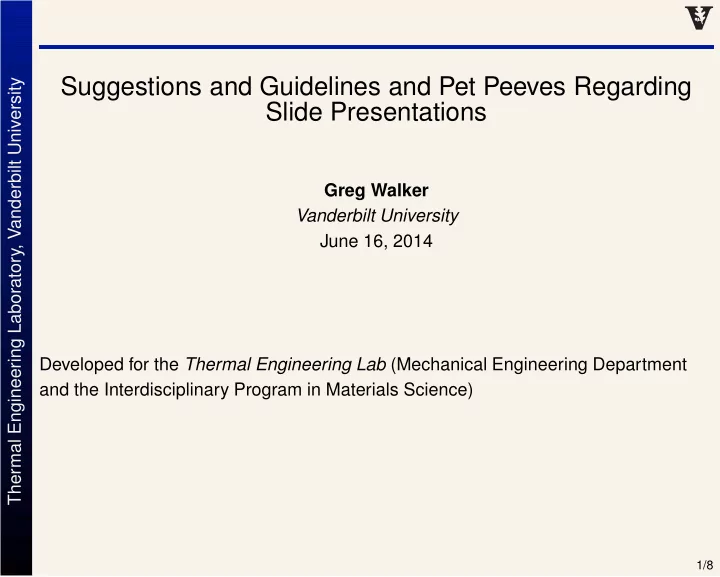

Suggestions and Guidelines and Pet Peeves Regarding Thermal Engineering Laboratory, Vanderbilt University Slide Presentations Greg Walker Vanderbilt University June 16, 2014 Developed for the Thermal Engineering Lab (Mechanical Engineering Department and the Interdisciplinary Program in Materials Science) 1/8
Title slide Thermal Engineering Laboratory, Vanderbilt University • Before you begin, it is customary to state that you are honored and that it is a pleasure to speak today. You may thank the audience for attending and so forth, but don’t gush. • The title slide should include these elements. – Descriptive title of the talk – Your name and co-authors (if the talk is on a specific paper, as in a conference format) – Author of the highlighted research (if it’s a review) – Affiliation and those of your coauthors (if different than yours) – Venue – Date – Sponsor logo if appropriate • The title slide also provides a great opportunity to outline the talk (see next slide) and introduce the main point of the talk. That is, tell them what you are going to tell them (see Rules at end). 2/8
Outline slide Thermal Engineering Laboratory, Vanderbilt University • For any talk less than 30 minutes, an outline slide is a waste of time and should be avoided. • Even if your talk is longer than 30 minutes, you probably still don’t need an outline slide. • If you absolutely must use an outline slide, be sure it gives the listener a road map that is substantially different than introduction, background, methods, results conclusions (or the many variations on this canonical scheme). • Did I mention that an outline slide is unnecessary? 3/8
Style (Words) Thermal Engineering Laboratory, Vanderbilt University • Pictures are usually better than words for descriptions. • However, label the key components in the picture with words. • If you steal a picture or a plot, make sure to attribute it on the same page where it’s displayed, preferably immediately under the stolen goods. Smaller type is ok, and use a shortened bibliographic notation (i.e. Science, 137(6), p.42, 1997). • If you need to use words, a bullet list is usually better than a paragraph. 4/8
Style (Visual) Thermal Engineering Laboratory, Vanderbilt University • Don’t use fancy transitions, harsh color schemes , lots of colors, flashing things , or ALL CAPS. This is how my 11 year old expresses his creativity. These features are not appropriate for a scientific talk. • Don’t use layers and reveals unless it really adds to the illustration. (They can be used quite effectively at times.) If you do use them, make sure there are no more than two, maybe three. • Don’t use comic sans font! – http://www.petitionspot.com/petitions/bancomicsans – http://online.wsj.com/news/articles/SB123992364819927171 5/8
Soft Style Thermal Engineering Laboratory, Vanderbilt University • Try to maintain a consistent look and feel (font, color scheme, layout, etc.) throughout the presentation. This is easy with templates or style files. • Font should be big enough for everyone in the audience to see. (Often this is tough to judge if you haven’t seen the auditorium.) • Prefer a sans-serif font to a serif font. • Simple navigation (page number) is ok, but status bars are distracting. • Don’t cheapen your hard work with clip art. 6/8
Denouement Thermal Engineering Laboratory, Vanderbilt University • The conclusions should not be simply a restatement of results. What did you learn that we did not know before the study was conducted? • Acknowledge your sponsors, co-authors and collaborators, but not your mother. • Dispense with the “Thank you” slide or the “Questions?” slide. If the forum expects a Q&A after the talk, leave the conclusions (or acknowledgments if that is the last slide) displayed and state that you would be delighted to entertain questions. 7/8
Rules (er, ... guidelines) Thermal Engineering Laboratory, Vanderbilt University 1. Rule of telling (don’t be afraid to repeat yourself): • Tell them what you are going to tell them (no surprises). • Tell them what you need to tell them. • Tell them what you told them. 2. Rule of thirds: • Everyone in the audience should understand the first third of your talk. • Most should understand the second third of your talk. • Only a handful should understand the last third of your talk. (Blow them away with your brilliance.) 3. Rule of proven ignorance: • If you can’t explain it, you probably don’t understand it. 4. Rule of spelling: • SPELL CHECK YOUR DOCUMENT! 8/8
Recommend
More recommend